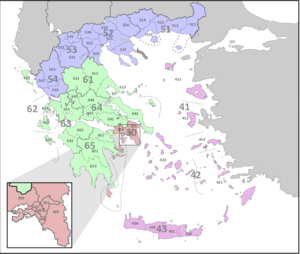Voreia Ellada

Voreia Ellada (Greek: Βόρεια Ελλάδα), meaning Northern Greece, is a first level NUTS administrative division of Greece created for statistical purposes by the European Union.
Until 2014, it encompassed the 4 regions East Macedonia and Thrace, Central Macedonia, West Macedonia and Thessaly. Coming into effect in January 2015, the Greek NUTS regions however have been redefined, now encompassing Epirus instead of Thessaly.[1]
Although this NUTS division is not used by Greece for any administrative purposes, the term "Northern Greece" is widely used to refer mainly to the two northern regions of Macedonia and Thrace; thus the Ministry for Macedonia and Thrace was known as "Ministry for Northern Greece" until 1988. The term may also colloquially incorporate the region of Thessaly as well as Epirus.
In linguistics, Northern Greece refers to the areas where the Northern Greek dialect is traditionally spoken, encompassing in addition to the previous regions Central Greece except for Attica, and the North Aegean, except Chios.[2]
Northern Greece statistics
According to 2011 Eurostat data, Voreia Ellada, as defined until 2014, had a total population 3.590.187 inhabitants.[3]
| Geographic division | Administrative divisions | Population (2011) | Capital | Notes |
|---|---|---|---|---|
| Macedonia[3] | West, Central and East Macedonia | 2,487,384 | Thessaloniki (Salonika) | It is the second largest geographical division in Greece by population, after Continental Greece. It is always included in Northern Greece. Greek Macedonians speak a northern Greek dialect.[2] |
| Thrace[3] | Thrace | 367,393 | Komotini | It is always included in Northern Greece, as the eastern portion of the region of East Macedonia and Thrace. Modern Greek Orthodox Thracians speak a northern Greek dialect, while the Muslim minority inhabiting the region are divided between the Turkish-speaking Western Thrace Turks and the Bulgarian-speaking Pomaks.[2] |
| Epirus | Epirus | 357,203 | Ioannina | It is located in north-western Greece. It is sometimes included in Northern Greece. Epirotes speak a northern dialect.[2] |
| Thessaly[3] | Thessaly | 735,410 | Larissa | It is sometimes included in Central Greece. Thessalians speak a northern dialect.[2] |
| North Aegean | North Aegean | 199,603 | Mytilene | This region is rarely included in Northern Greece, as it is mainly included in the Aegean Islands region. Most people from these islands speak a northern as well as an eastern dialect. That's why they have been historically connected to other Eastern Greeks ("Anatolites" or "Mikrasiates") from Anatolia, along with the Dodecanesian islanders, who speak an eastern dialect. |
| Wider sense of Northern Greece | 4,146,993 | Thessaloniki (largest city) | 3,947,390 inhabitants without North Aegean islands. Northern Greece in the strict sense (Macedonia, Thrace) includes 2,854,777 inhabitants. | |
References
- ↑ European Commission (18 December 2013). "Commission Regulation (EU) No. 1319/2013 of 9 December 2013". Official Journal of the European Union. Retrieved 9 March 2015.
- ↑ 2.0 2.1 2.2 2.3 2.4 "Βόρειες διάλεκτοι" [Northern Dialects] (in Greek). Portal for the Greek Language. 2008-06-20. Retrieved 11-04-2011. Check date values in:
|accessdate=(help) - ↑ 3.0 3.1 3.2 3.3 "Population on 1 January by broad age groups and sex - NUTS 3 & 4 regions". eurostat. 2012-11-26. Retrieved 05-12-2012. Check date values in:
|accessdate=(help)